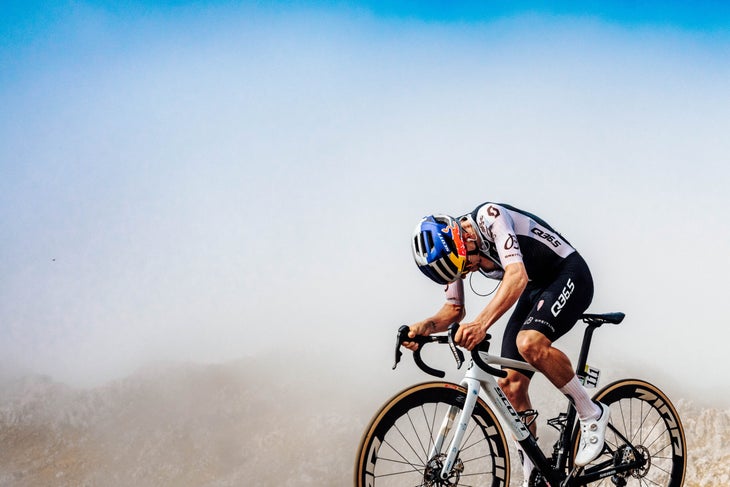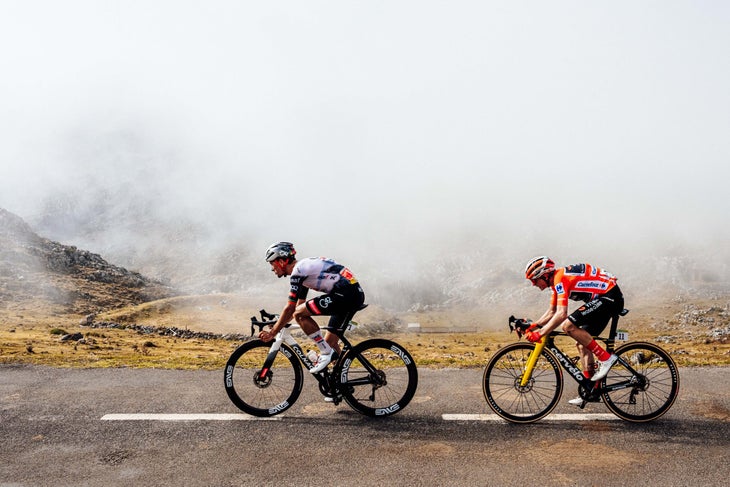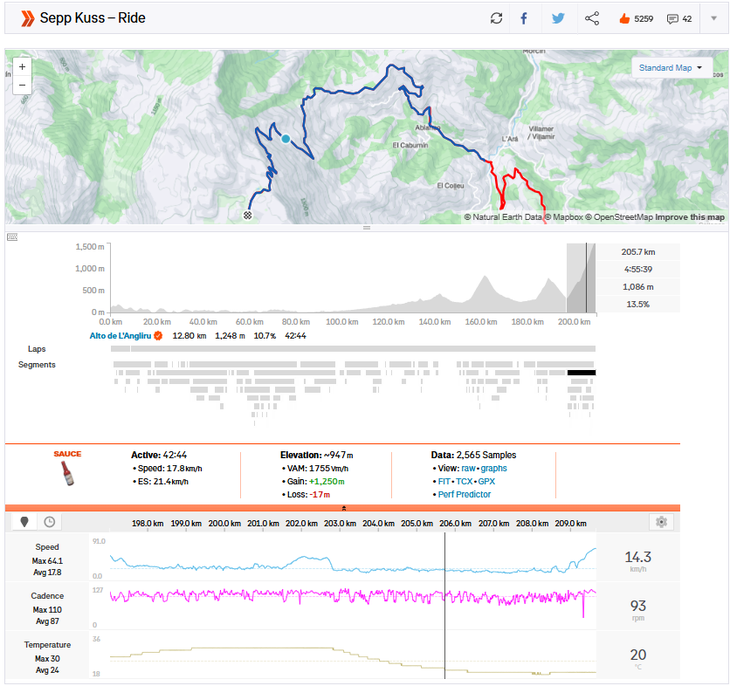Vuelta Power Analysis: Almeida's Career Performance on the Angliru

(Photo: Chris Auld)
Alto de l’Angliru is one of the hardest climbs in cycling. Just listen to these stats: 12.4km at 9.8%, including 6.9km at 13.4% and a 600-meter wall with an average gradient of 21%. The fastest climbers in the Vuelta a España, Almeida and Vingegaard, climbed that wall at an average of 9.8 kph (6.1 mph).
Daan Hoole, helping lead Mads Pedersen and the groupetto, climbed the Angliru wall at 5.8 kph (3.6 mph). It took them nearly six minutes to go 600 meters, and it probably would have been faster to walk at that point. The suffering wasn’t just for the sprinters on the Angliru, nor was it reserved for the climbers. The suffering was for everyone — fast or slow, short or tall, light or large, the Alto de l’Angliru is one of the hardest climbs ever.
So it is no surprise that pundits marked Angliru as the turning point of the Vuelta. Up to stage 13, there hadn’t been major GC action apart from Vingegaard’s attack on stage 9. Before the Angliru, the top 10 in the GC were separated by less than three minutes, and there was less than a minute between the entire podium.
Few expected Almeida to drop Vingegaard on the Angliru, and even more expected Tom Pidcock to completely blow up. When the peloton began to the penultimate climb of the Alto del Cordal, it seemed that all three teams — UAE Team Emirates-XRG, Team Visma Lease-a-Bike, and Q36.5 Pro Cycling Team — all believed in their rider’s chances.
Similar Reads

Abel Balderstone, the 25-year-old climber on Caja Rural-Seguros RGA, would go on to finish 10th on the Angliru, and he spent the majority of the stage following the GC contenders at the front of the peloton. Balderstone climbed the Cordal in 17 minutes at roughly 6.2w/kg. It wasn’t the most ferocious pace in the peloton, but it wasn’t an easy one, either.
Juan Ayuso, who many hoped would play a key role in helping Almeida on l’Angliru, dropped on the Cordal, along with teammate Marc Soler. The peloton was shrinking by the second, and the hard part hadn’t even begun.
The same can be said about the first 6km of the Angliru which average 7.5%. It is still a hard climb, but nothing compared to what was to come. Jay Vine and Felix Großschartner set the pace on this section of the climb, pulling at a very hard pace that was, at times, too much for Almeida. The Portuguese kept dropping off his teammates’ wheels, but only by a few meters, in order to maintain his strict pacing strategy.
Pacing is a recurring theme on l’Angliru, and we’ll see multiple riders seemingly come back to life in the second half of the climb.
With around 7km to go, Almeida came to the front and began pulling. Vingegaard was on his wheel, followed by Sepp Kuss and Jai Hindley. The others began to drop away, including Pidcock, Felix Gall, and Balderstone.
For the next 6km, Almeida pulled…and pulled…and pulled. I’m not sure he looked back once. Though, Vingegaard looked back when he saw Kuss and Hindley dropping. Almeida ground his way over the 21% section of the climb, riding as hard as he could in an attempt to drop Vingegaard. But the Dane remained, glued to Almeida’s wheel.

With 1.5km to go, Almeida put in a big dig, pedaling at more than 100 rpm for the first time in a few kilometers, trying one last time to break the race leader. But Vingegaard was still there. He wasn’t looking or feeling great, but he was there.
Almeida led through the final downhill corners, and took the stage win a bike length ahead of Vingegaard. Both riders had just about tied the Angliru record, which was set by Roberto Heras in 2000. Back in 2023, Primož Roglič and Vingegaard were 24 seconds slower than Heras, mainly due to a slower pace at the first part of the climb.
Looking at the numbers, it is clear this was one of Almeida’s best climbing performances ever. It wasn’t enough to drop Vingegaard, but it was enough to drop everyone else in the Vuelta.

Almeida – Alto de l’Angliru
- Time: 41:10
- Estimated Average Power: ~410w (6.5w/kg)
Vingegaard did a solid performance on l’Angliru, but he wasn’t at his best. In fact, Vingegaard was much stronger only two months ago at the Tour de France, where he climbed Mont Ventoux in 54 minutes and 32 seconds at an average power of ~6.5w/kg. When you account for the altitude and attacking nature of that climb, Vingegaard produced around 6.7w/kg for 40 minutes on Ventoux, a much stronger performance than on l’Angliru.
As for the others, Kuss and Hindley were incredibly strong to finish third and fourth on the stage. They both produced 6.4/kg for 41 minutes 40 seconds, while Pidcock did a career-best performance, climbing l’Angliru at 6.3w/kg for 42 minutes and 26 seconds.
What have we learned from the Alto de l’Angliru? We learned that João Almeida can win this Vuelta. He gained four bonus seconds on Vingegaard today, and he was clearly stronger having pulled the entire climb.
Pidcock and Hindley look like they will battle for the podium, but they are closely followed by Felix Gall, Giulio Pellizzari, Matthew Riccitello, and Giulio Ciccone. None of these riders are exceptional time trial riders; but we all thought the same thing about Sepp Kuss during the 2023 Vuelta. The American went on to finish 13th in that year’s 25.8km time trial, losing only 11 seconds to Vingegaard and 39 seconds to Almeida. Look out for a surprise in Stage 18’s TT in Valladolid.
Power Analysis data courtesy of Strava
Strava sauce extension
Riders:
- Jonas Vingegaard
- João Almeida


